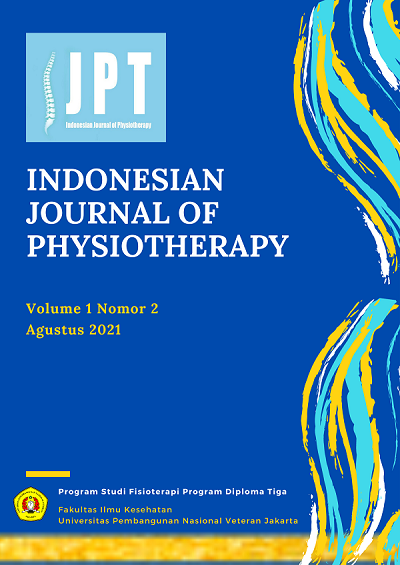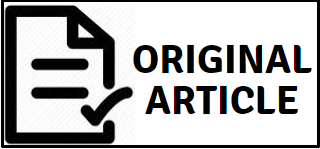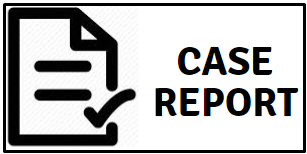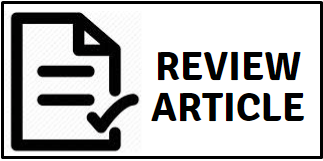EFEKTIVITAS MIRROR THERAPY EXERCISE TERHADAP KEMAMPUAN FUNGSIONAL WAJAH PENDERITA FACIAL PALSY : STUDI LITERATUR
DOI:
https://doi.org/10.52019/ijpt.v1i2.3322Kata Kunci:
penderita facial palsy, mirror therapy exercise, kemampuan fungsional wajah.Abstrak
Latar Belakang : Facial palsy adalah suatu kondisi neurologis yang memengaruhi fungsi motorik wajah ditandai dengan asimetri dan kelemahan otot sebagian atau seluruh wajah sehingga menurunkan kemampuan fungsional wajah. Mirror therapy exercise merupakan suatu latihan berupa senam wajah dengan meggunakan cermin atau software untuk menghasilkan umpan balik visual dari bagian tubuh yang terkena lesi dan menghasilkan gerakan di sisi tubuh yang terkena. Tujuan : Untuk mengetahui efektivitas mirror therapy exercise terhadap kemampuan fungsional wajah penderita facial palsy melalui kajian literatur. Metode Penelitian : Jenis penelitian ini deskriptif dengan desain studi literatur. Literatur 10 tahun terakhir dikumpulkan dari 16 search engine dengan menggunakan teknik PICOS. Selanjutnya diseleksi awal dan metodologi, lalu dimasukan ke aplikasi Mendeley untuk literatur terduplikasi. Literatur yang eligible diekstraksi dengan filterisasi metode CONSORT. Hasil : Berdasarkan7 literatur yang eligible, mirror therapy exercise dengan kombinasi ataupun modifikasi efektif dalam meningkatkan kemampuan fungsional wajah penderita facial palsy. Kesimpulan : Berdasarkan kajian literatur, mirror therapy exercise dapat digunakan untuk meningkatkan kemampuan fungsional wajah penderita facial palsy.Referensi
Abidin, Z., . K., & Haryanto, D. (2017). Pengaruh Infra Red, Massage dan Mirror Exercise pada Bell’s Palsy. Jurnal Fisioterapi Dan Rehabilitasi, 1(2), 18–25. https://doi.org/10.33660/jfrwhs.v1i2.56
Akina Tamaki, MD Claudia I. Cabrera, MD, MS Shawn Li, MD Cyrus Rabbani, MD Jason E. Thuener, MD Rod P. Rezaee, MD Nicole Fowler, M. (2021). Incidence of Bell Palsy in Patients With COVID-19. JAMA Otolaryngology–Head&Neck Surgery, 147(Number 8), 767. https://doi.org/10.1056/nejmoa2034577
Barth, J. M., Stezar, G. L., Acierno, G. C., Kim, T. J., & Reilly, M. J. (2020). Mirror Book Therapy for the treatment of Idiopathic Facial Palsy. Ear, Nose and Throat Journal, 93(9), 0–4. https://doi.org/10.1177/0145561320913211
Bharathi, K., Ramya, S., & Malarvizhi, P. D. (2019). The Efficacy of Mirror Therapy in Facial Palsy among Subjects with Facial Paralysis. International Journal of Research and Scientific Innovation (IJRSI) |, VI(IX), 9–13. https;//www.rsisinternational.org
Bukhari, S., Majeed, S., Noor, S., & Khan, S. (2020). Effects of mirror therapy on Bells palsy. Journal of Riphah College of Rehabilitation Sciences, 8(1), 37. https://doi.org/10.5455/jrcrs.2020080108
Chang, Y. S., Choi, J. E., Kim, S. W., Baek, S. Y., & Cho, Y. S. (2016). Prevalence and associated factors of facial palsy and lifestyle characteristics: Data from the Korean National Health and Nutrition Examination Survey 2010-2012. BMJ Open, 6(11), 1–7. https://doi.org/10.1136/bmjopen-2016-012628
Chen, W., Yuan, T., Wang, Y., & Ding, J. (2017). Human mirror neuron system and its plasticity. Neural Regeneration Research, 3(3, March 2008), 321–323.
Codeluppi, L., Venturelli, F., Rossi, J., Fasano, A., Pacillo, F., Cavallieri, F., Giorgi Rossi, P., & Valzania, F. (2020). Facial palsy during the COVID-19 pandemic. Brain and Behavior, August, 1–5. https://doi.org/10.1002/brb3.1939
Deconinck, F. J. A., Smorenburg, A. R. P., Benham, A., Ledebt, A., Feltham, M. G., & Savelsbergh, G. J. P. (2015). Reflections on mirror therapy: A systematic review of the effect of mirror visual feedback on the brain. Neurorehabilitation and Neural Repair, 29(4), 349–361. https://doi.org/10.1177/1545968314546134
Dewi, A. C., Kurniawan, S. N., Husna, M., & Rahayu, M. (2014). Regenerasi saraf perifer. In Neurona (Vol. 32, Issue 1)
Demarin, V., Morović, S., & Béné, R. (2014). Neuroplasticity. Periodicum Biologorum, 116(2), 209–211. https://hrcak.srce.hr/126369
Ding, L., Li, L., Xu, Z., Tian, J., Chen, S., Wang, H., Yang, M., Cui, X., Cao, L., & Jia, J. (2020). Computer vision technology-based face mirroring system providing mirror therapy for Bell’s palsy patients. Disability and Rehabilitation, 42(6), 833–840. https://doi.org/10.1080/09638288.2018.1510551
Egilmez, O. K. (2021). Can COVID-19 Cause Peripheral Facial Nerve Palsy ?. SN Comprehensive Clinical Medicine, 12–14. https://doi.org/https://doi.org/10.1007/s42399-021-00967-4
Eliyspoor C Baghban, D., Akbarzadeh, A., Oshnari, L. A., Mirzakhani, N., Parsamanesh, T., Kamalifar, M., & Javantash, A. (2017). The Comparison between Exercise Therapy and Biofeedback Therapy in Facial Function and Quality Of Life of Bell’s palsy. JCPR Journal of Clinical Physiotherapy Research Original Article Journal of Clinical Physiotherapy Research, 2(3), 139–143. http://journals.sbmu.ac.ir/physiotherapy/
Goldie, S., Sandeman, J., Cole, R., Dennis, S., & Swain, I. (2016). Electrical stimulation treatment for facial palsy after revision pleomorphic adenoma surgery. Journal of Surgical Case Reports, 2016(4), rjw057. https://doi.org/10.1093/jscr/rjw057
Hassan, A., Mustafa, K., & Suleiman, A. M. (2020). Bell ’ s Palsy : A Prospective Study. International Journal of Dentistry, 2020, 1–5. https://doi.org/https://doi.org/10.1155/2020/2160256
Jason C. Nellis, M., Masaru Ishii, MD, P., Patrick J. Byrne, MD, M., Kofi D. O. Boahene, M., Jacob K. Dey, M., & Lisa E. Ishii, M. (2017). Association Among Facial Paralysis, Depression, and Quality of Life in Facial Plastic Surgery Patients Jason. JAMA Facial Plastic Surgery, 19(3), 190–196. https://doi.org/10.1001/jamafacial.2016.1462.
Kang, J. A., Chun, M. H., Choi, S. J., Chang, M. C., & Yi, Y. G. (2017). Effects of mirror therapy using a tablet PC on central facial paresis in stroke patients. Annals of Rehabilitation Medicine, 41(3), 347–353. https://doi.org/10.5535/arm.2017.41.3.347
Martineau, S., Rahal, A., Piette, É., Chouinard, A. M., & Marcotte, K. (2020). The Mirror Effect Plus Protocol for acute Bell’s palsy: a randomised and longitudinal study on facial rehabilitation. Acta Oto-Laryngologica, 0(0), 1–6. https://doi.org/10.1080/00016489.2020.1842905
Masterson, J. (2015). The Role of Emotion , Vision and Touch in Movement Learning Neuroplasticity and the Mirror Neuron System. Journal of Psychology and Clinical Psychiatry, 3(5), 1–9. https://doi.org/10.15406/jpcpy.2015.03.00149
Moch, B. (2017). Bell’s Palsy (BP). Saintika Medika, 7(2), 20–25. https://doi.org/10.22219/sm.v7i2.4073
Mohanty, C. B., Bhat, D., & Indira Devi, B. (2015). Role of central plasticity in the outcome of peripheral nerve regeneration. Neurosurgery, 77(3), 418–423. https://doi.org/10.1227/NEU.0000000000000851
Oke, I. O., Oladunjoye, O. O., Oladunjoye, A. O., Paudel, A., & Zimmerman, R. (2021). Bell’s Palsy as a Late Neurologic Manifestation of COVID-19 Infection. Cureus, 13(3), 13–16. https://doi.org/10.7759/cureus.13881
Paolucci, T., Cardarola, A., Colonnelli, P., Ferracuti, G., Gonnella, R., Murgia, M., Santilli, V., Paoloni, M., Bernetti, A., Agostini, F., & Mangone, M. (2020). Give me a kiss!: An integrative rehabilitative training program with motor imagery and mirror therapy for recovery of facial palsy. European Journal of Physical and Rehabilitation Medicine, 56(1), 58–67. https://doi.org/10.23736/S1973-9087.19.05757-5
Rowhani-Rahbar, A., Baxter, R., Rasgon, B., Ray, P., Black, S., Klein, J. O., & Klein, N. P. (2012). Epidemiologic and clinical features of Bell’s palsy among children in Northern California. Neuroepidemiology, 38(4), 252–258. https://doi.org/10.1159/000338303
Vaughan, A., Gardner, D., Miles, A., Copley, A., Wenke, R., & Coulson, S. (2020). A systematic review of physical rehabilitation of facial palsy. Frontiers in Neurology, 11(March). https://doi.org/10.3389/fneur.2020.00222









